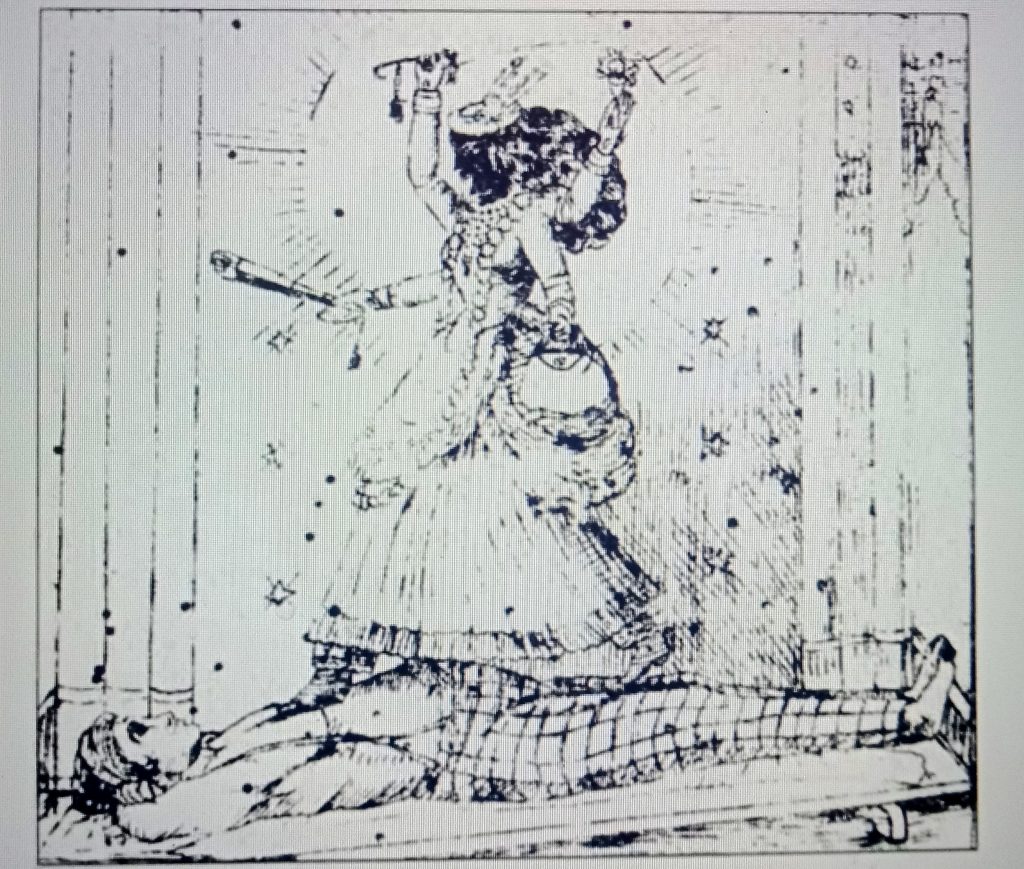Game on in Bengal
Published @ The Indian Express
To view the published version, see
The Indian Express

An etching that puns on the Kali figure.
There cannot be a three-way election in 2021. That would mean an advantage for BJP, as it will cannibalise on the factionalism in the TMC and on the irrelevance of the CPIM.
The dictionary meaning of blunderbuss is two-fold. The more archaic meaning stands for a gun with a short, large barrel, to be fired only at close range. The second meaning refers to an action lacking subtlety and precision. Either way, what the BJP is planning in Bengal is a textbook case of blunderbuss. It has gone to the state — which goes to the poll in the early half of 2021 — with all guns blazing. It has parked there, the head of its IT Cell. A Bengal-specific division of the raucous Republic TV has been bankrolled.
To organisationally unsettle Bengal BJP’s insouciance, the home minister recently paratrooped to induct one chieftain and several local turncoats, mostly from the Trinamool Congress but also from the Congress and the CPI(M). If this is the barrel for shooting, the other part of the blunderbuss, one can bet, will also lack any subtlety. It would be the same story of courting dodgy defectors with plum positions; creating a narrative of a long-suffering Bengal under Marxists and autocrats; unearthing imaginary traumas of Partition; canvassing the fiction of rampaging Bangladeshi infiltration; holding high-octane rallies with one-penny actors and a prevaricating prime minister; instigating localised communitarian violence; and hop-in and hop-off flirtations with Bengal’s long list of talismans — Tagore for breakfast, Vivekananda for lunch, Subhas Bose for dinner. So much and so forth. The question hence is not what BJP will do in Bengal. The question is, knowing the narrative, what the other parties would.
Nothing binds the Trinamool’s foot soldiers more than their genuflecting loyalty to a firebrand shibboleth. Notwithstanding 10 years in power and a handful of penetrative welfare policies, Mamata Banerjee remains an impenitent autocrat of a shambolic party, which is otherwise made of local mafiosi eking out political fortunes from the crumbs of a gig economy. To that end, only a prospect of a win in the next polls can keep her minions together. At the same time, Mamata is a popular leader, has extensive acceptability, commands widespread loyalty and has not yet lost her street-fighting genes. So, in spite of her party, Mamata is still a substantive political force. At least till today.
The state of the Left is a concoction of delusion and denial. It is deluding itself if, according to several reports, it is considering backing the BJP furtively to root out the TMC, so that it can make a triumphant return in 2026. This is like the squirrel tempting the wolf to tame the cat. Even if the cat survives the wolf, the squirrel won’t. Also, unless it has lost all its marbles, the Left will do well to remember that the RSS reserves its sincerest disgust for it. So, both politically or ideologically, providing any grease to the BJP’s juggernaut would be hara-kiri, now and in the foreseeable future. This is more so, because the Left continues to have a significant voter base among those sore with Mamata’s vulgar populism. As for the Congress, very little can be said about its prospects in Bengal more than it can be said elsewhere, though it has a small but loyal faction of voters, especially in parts where the Congress continues to have active presence and key local leadership.
TMC, BJP and a CPM-Congress combine have hinted that they will fight each other in the polls. But facts and the political winds are chiming one simple arithmetic: That there cannot be a three-way election in 2021. That would mean an advantage for BJP, as it will cannibalise on the factionalism in the former and on the irrelevance of the latter. If the BJP is to be defeated, the TMC and the Left-Congress combine must come together to form a strategic alliance. There is immediate and successful precedence in Maharashtra, while the grand alliance in Bihar, even in defeat, has created the promise of a non-BJP future. History is witness that after a millennia of fighting each other, France and Britain did come together against Germany in both the world wars. Why is it such an impossible prospect in Bengal?
An alliance is going to ensure — mathematically speaking — an unassailable political behemoth; and will be electorally insurmountable even if the BJP unleashes its most diabolic campaign. An alliance will also cut down on cost, disincentivise defection and allegations of dynasticism in TMC. It would also minimise the political violence that Bengal routinely witnesses before polls. These are quantifiable gains. So, what is at stake?
First, if the Left is willing to court BJP and sit out till 2026 (hypothetically counting their return to glory), why not do the same instead for TMC? For after Mamata, there would be no TMC to speak of anyway, giving a real chance to CPI(M)’s so-far unreal hopes. Second, Bengal’s history for decades since the 1960s is full of the bloody rivalry between local Congress and CPI(M). If that can be conveniently forgotten to forge an alliance, why not the same for TMC? Third, a coalition in power will keep Mamata’s monocracy in check, end CPM’s long isolation from governance; and create a pool of political progeny for the future. As for TMC, it is anyway a party without a belief, so how will it matter if it sides with the Left?
Most importantly, such a strategic and timely alliance would successfully turn the tables on BJP’s spin doctors, while ensuring that Bengal does not suffer the ignominy of having fallen to the ultra-right. What can be better for Bengal?
comments for this post are closed